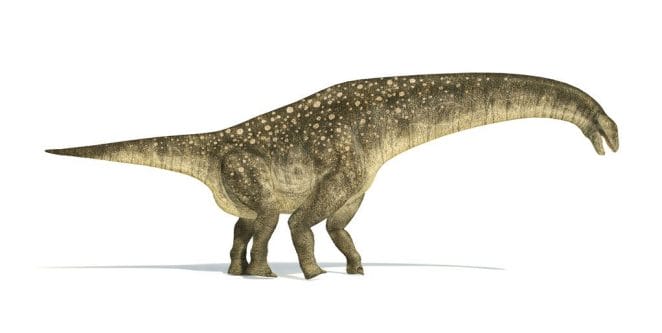Richard Lydekker called Titanosaurus in 1877 after discovering fossils in the Lameta Formation of India. The typical species, T. indicus, was the first Indian dinosaur discovered. Soon after, scientists from throughout the world began to allocate additional individuals (to the typical species) and new species to this genus.
It even happened that a new species was developed within the genus Titanosaurus based on individual animal bones, making it roughly a “trash” for individual bone fragments. As a result, Titanosaurus is assigned to dinosaurs existing on practically every continent, as well as from the early Cretaceous (Barrem) until the end of the Cretaceous (Maastricht), which is improbable.
Current studies have assigned some titanosaur species to new genera, while others are still classified as nomen dubium.
Find out more facts about Titanosaurus.
1: Titanosaurus quick facts:
Name: Titanosaurus (Greek for “Titanic Lizard”); pronounced tight-a-no-saw-rus
When it lived: Late Cretaceous, 70 million years ago
Type of dinosaur: Sauropod
Location: India
Habitat: forest.
Length/Weight: 9-12 Meters/15240kg
Diet: Herbivorous
Distinguishing Characteristics: Titanosaurs had long tails, necks, and small heads.
Named by: Lydekker (1877)
2: How do you pronounce ‘Titanosaurus’?
The name Titanosaurus should be pronounced “tight-a-no-saw-rus.”
3: What does the name Titanosaurus mean?
Titanosaurus was called after the mythological Gods known as the Titans. These Gods were from Greek mythology prior to the Olympic Games. The name ‘Titanosaurus’ literally translates to ‘titanic lizard.’ This dinosaur was given this name because it was thought to be an aquatic reptile.
4: What Did Titanosaurus Look Like?
Titanosaurus was a massive dinosaur. It resembled a lizard in appearance. Titanosaurus, like a lizard, had a long tail and neck, while the head was much smaller in comparison to its long and huge body.

The manner these huge dinosaurs’ legs were formed set them apart from other sauropods. The legs were wider, allowing them to take a wider stance. The records and data on the content of the specimens discovered demonstrate that they had a stocky and lengthy physique.
Data also suggests that they were black, grey, and white in colour. All of this information about the Titanosaurus’s physical appearance has come from their remains, which consisted of bones and bone protrusions that made up the Titanosaurus skeleton.
Sources:Wikipedia





GIPHY App Key not set. Please check settings